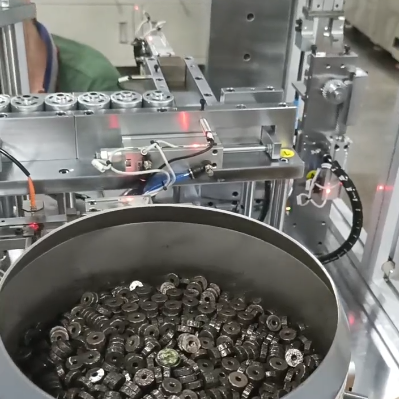What are the common electrical faults and solutions for DC motor motor automatic bearing press fitting machine?
1, power failure
Fault phenomenon:
The equipment can not start, the power indicator does not light up.
Sudden power failure during the operation of the equipment.
Cause analysis:
External power failure, such as power failure, loose plug, damaged socket or broken power cord.
The fuse inside the device is blown, possibly due to a short circuit or overload.
The power switch is damaged, the internal contacts have poor contact or the mechanical structure is faulty.
Solution:
Check the external power supply to verify that the power is not out. If the plug is loose, tighten the plug; if the socket is damaged, replace the socket; a broken power cord requires replacement of the power cord.
Check the fuse, if it is blown, first find the cause of short circuit or overload. After troubleshooting, replace the fuse with the same specification.
For damaged power switches, disassemble the equipment shell and check the inside of the switch. If it is a contact problem, you can use sandpaper to polish the contacts; if the mechanical structure is damaged, replace the power switch with a new one.

2、Motor failure
Fault phenomenon:
The motor does not rotate, but there is a buzzing sound.
The motor speed is abnormal, too fast or too slow.
The motor runs with serious heat, and even smoke.
Cause analysis:
The motor winding is short-circuited or disconnected, probably due to prolonged use, moisture, overload or motor quality problems.
The brushes of the motor are badly worn, resulting in poor contact and affecting the normal operation of the motor.
The load of the motor is too large, exceeding the rated power of the motor, or the mechanical parts are stuck, so that the motor can not rotate normally.
Solution:
Use an insulation resistance meter to check the insulation resistance of the motor windings to determine whether they are short-circuited or disconnected. If the windings are damaged, the motor needs to be rewound or replaced.
Open the brush cover of the motor and check the wear of the brushes. If the brushes are worn beyond the specified range, replace them with new brushes and make sure that the brushes are in good contact with the commutator.
Check the load on the motor and reduce unnecessary loads. If the mechanical parts are stuck, find out the reasons for the jamming, such as bearing damage, transmission parts jammed, etc. Repair or replace the faulty parts so that the motor can run smoothly.
3、Sensor failure
Failure phenomenon:
The automated operation of the equipment is inaccurate, such as bearing press fitting position deviation, pressure control is inaccurate.
Sensor signal abnormality, the control system can not normally receive or process the sensor signal.
Cause analysis:
The sensor is installed in an improper position, subject to vibration, collision or dust, oil and other pollution, affecting the detection accuracy.
The sensor itself is damaged, and the internal components are aged, short-circuited or disconnected, resulting in abnormal signal output.
The connecting wire of the sensor is loose, broken or short-circuited, which interrupts or distorts the signal transmission.
Solution:
Re-adjust the installation position of the sensor to ensure that it is firmly installed and meets the detection requirements. Clean the surface of the sensor to remove dust, oil and other contaminants to ensure that the sensor can be detected normally.
Use a multimeter and other tools to check the sensor resistance, voltage and other parameters, to determine whether the sensor is damaged. If damaged, replace the sensor with the same model and calibrate it.
Check the connection lines of the sensor, repair loose connections, and replace damaged lines. When connecting the lines, make sure the connections are correct and firm to avoid signal interference.
4、Controller failure
Failure phenomenon:
The operating program of the equipment can not run normally, such as confusion in the press-fitting process, parameter settings can not be saved.
The display of the controller is faulty, such as black screen, flower screen or display error messages.
Cause analysis:
The controller's program has errors, which may be due to loopholes in the program itself, electromagnetic interference or illegal operation.
Hardware failure of the controller, such as chip damage, circuit board short circuit or power module failure.
Failure of the storage device, resulting in the program and parameters being lost or unreadable.
Solution:
For program errors, try restarting the device to see if it returns to normal. If the problem persists, contact the device manufacturer for a program update or fix patch. At the same time, check whether there is a strong source of electromagnetic interference around the device and take shielding measures.
Check the controller's hardware for obvious signs of damage on the circuit board, such as burnt, detached components, and so on. If damage to the chip or other components is suspected, professional maintenance personnel are required to carry out testing and repair. For power module failure, replace the power module with one of the same specifications.
Check the storage devices, such as hard disk, memory card, etc. If the storage device is damaged, try to repair or replace it. After replacing the storage device, reinstall the program and parameters.
5、Relay and contactor failure
Fault phenomenon:
The electrical control part of the device cannot switch the circuit normally, such as the motor cannot start or stop, and the pressure control element cannot work.
The relay or contactor operates abnormally, with obvious noise or jitter.
Cause Analysis:
The contacts of the relay or contactor are worn, abraded or sticking, resulting in the circuit not being able to be switched normally.
Damaged coils, possibly due to overvoltage, overcurrent or deterioration of insulation due to prolonged use.
Failure of mechanical parts, such as armature jamming, spring failure, affecting the normal operation of the relay or contactor.
Solution:
Open the relay or contactor case and check the condition of the contacts. If the contacts are worn or abraded, sandpaper can be used to gently sand the contacts; if the contacts are sticking, the relay or contactor needs to be replaced with a new one.
Use a multimeter to check the resistance of the coil to determine if the coil is damaged. If the coil is damaged, replace the coil with the same model or the entire relay/contactor.
Check the mechanical parts, clean the surface of armature and core for impurities, and check the spring elasticity. If the mechanical parts are damaged, repair or replace the defective parts to ensure that the relay or contactor can operate normally.
※ If you still can not solve the problem by the above ways and means, please contact the technical specialists of Xinhui Electromechanical Equipment Co.







